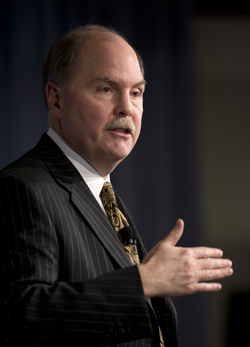
More top managers will be leaving General Motors Corp. as the auto maker looks to slim down its ranks and retool its long-held business culture, widely blamed for the downfall that has landed the company in federal bankruptcy court.
“We will be making changes in both our structure and processes to run the business, which includes, for example, reducing (executive) manpower by 34% from year-end 2008 to 2009,” CEO Fritz Henderson says in a wide-ranging online chat session with reporters. “Yes, there will be significant change.”
Among those already having exited the auto maker, in addition to former CEO Rick Wagoner, forced out by the Obama Admin., are purchasing chief Bo Andersson and former premium-brand head Mark McNabb. Vice Chairman Robert Lutz will retire at year’s end.
However, Henderson says there has been no change either up or down in the auto maker’s stated plans to cut about 35% of its executive ranks and 20% of its salaried manpower before the end of the year.
He also downplays criticism the U.S. government is too involved in calling the shots at GM.
“The (government) has been clear that it wants the management to turn around the company, and (it) expects the board to continue to exercise strong oversight and follow the leading edge of corporate governance principles.”
Earlier on GM’s website, Henderson addressed the issue of the auto maker’s culture problem.
“Of all the things that people believe will hold us back, our culture is mentioned most,” Henderson writes. “GM must work through the Chapter 11 process to become leaner, more competitive and profitable once again.
“(But) we can’t just be a smaller GM; we need to be a different GM, too,” he says, adding the biggest challenge will be to encourage “greater risk-taking.”

“Risk aversion stems in part from 75 years of being the biggest auto maker in the world,” Henderson says. “By playing ‘not to lose,’ we sometimes lost our way. We’re changing that right now.”
He says a team has been formed to “further define” GM’s culture-change path.
In his Web chat Henderson also:
- ùReveals GM has reversed decisions to close 49 of its U.S. dealers and will complete its review this week. He also says more than 99% of its surviving dealers have agreed to a new initially controversial franchise agreement GM later modified after a protest from the National Automobile Dealers Assn. “We were particularly appreciative of the feedback received from (the) NADA on our first agreement. We turned around modifications quickly, and have obviously received great support for the final version.”
- Predicts pending cash-for-clunkers legislation could boost U.S. industry retail sales 10%, and says he expects GM to get its full share of that gain.
- Sees signs of an economic turnaround. “Yes, we are seeing stability, albeit at anemic levels,” he writes. “Still, better to not be falling.” He says the market is tracking along with assumptions made in GM’s recovery plan.
- YDefends the move to close, rather than sell, Pontiac. “In the end, we did not see the same potential (as with Hummer, Saturn and Saab – all with tentative sales deals), to be honest, for Pontiac.” He also slams the lid on speculation the Pontiac G8 sports sedan could survive as part of another brand’s stable. “I am not for rebadging,” he says.
- ùSays based on preliminary plans, he expects Koenigsegg Group AB, which has made a tentative offer to acquire Saab Automobile, to contract GM for production of the planned 9-4 cross/utility vehicle based on the revamped front-drive Cadillac SRX. Henderson says Saab still has “outstanding appeal (and) incredibly loyal customers and dealers,” but that GM had to abandon the brand because “we ran out of money just on the eve of launching the newest generation of Saabs, which we think will be outstanding.”
- ”Holds out little hope for rescinding any more plant-closure plans. “Unfortunately, these are all (every single one) tough calls,” he says. “I have recently indicated to a senior person that there are no more ‘bad plants,’ only good ones with good people. Our problem, however, is that we simply must bring our capacity in line with demand, and we have no real alternative other than to execute our plan.”
- Indicates U.S. market reaction to the auto maker’s bankruptcy has been less negative than expected. “Since March of this year, we have seen small improvements in sales on a monthly basis. June looks like a similar trend.”




